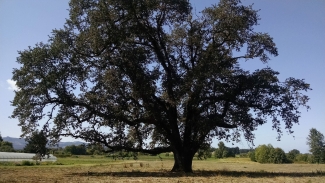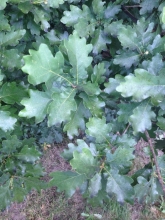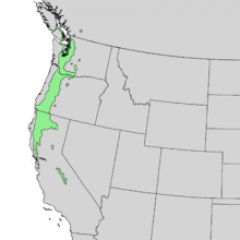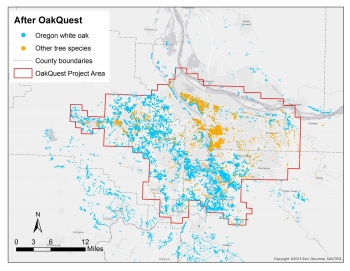Mapping an imperiled Oregon species
By Lori Hennings, June 3 2015
 If you have Oregon white oak trees in your yard, you know they are the last trees to get their spring leaves and the last to lose them in the fall. They make a mess after you’ve raked everything else up, and drop noisy acorns (often squirrel-assisted) on your roof. They sprinkle your yard with mossy little twigs. So why do you keep them?
If you have Oregon white oak trees in your yard, you know they are the last trees to get their spring leaves and the last to lose them in the fall. They make a mess after you’ve raked everything else up, and drop noisy acorns (often squirrel-assisted) on your roof. They sprinkle your yard with mossy little twigs. So why do you keep them?
 That’s easy. They are simply gorgeous. Just looking at a big, old mushroom-shaped oak makes me feel happy and kind of puts me in my place in the universe. They are also awesome to sit under, swing from and climb.
That’s easy. They are simply gorgeous. Just looking at a big, old mushroom-shaped oak makes me feel happy and kind of puts me in my place in the universe. They are also awesome to sit under, swing from and climb.
Here are some things you may not know about our native Oregon white oak. Its range is limited (see map), and it often co-occurs with native prairie habitat. Native Americans have profound cultural ties to these habitats, and historically have managed them by setting fires to burn away encroaching Douglas-fir and other trees that grow faster and eventually shade out the oak trees. Turns out oak trees are conveniently fire-resistant.
 More than 95 percent of our oak-prairie habitats have disappeared from the Willamette Valley, mostly due to farming, urbanization and fire suppression. Nearly 400 plant species live pretty much only in these habitats, and wildlife species like white-breasted nuthatches and Western gray squirrels have declined in tandem with habitat loss.
More than 95 percent of our oak-prairie habitats have disappeared from the Willamette Valley, mostly due to farming, urbanization and fire suppression. Nearly 400 plant species live pretty much only in these habitats, and wildlife species like white-breasted nuthatches and Western gray squirrels have declined in tandem with habitat loss.
Alas, we don’t have a good handle on where to find the remaining habitat. In fact, creating an oak map is one of the highest priorities identified in the Portland-Vancouver Regional Conservation Strategy. We need to identify the most important remnants to protect, restore and acquire from willing sellers, in order to create a system of key habitat areas connected by biodiversity corridors.
 That’s all kind of depressing. What can we do about it? Here's where The Intertwine Alliance’s Oak Prairie Work Group (OPWG) comes in. Twenty-seven partner organizations are working together to produce a high-quality Oregon white oak map for the Portland region. OakQuest is funded by the U.S. Fish and Wildlife Service, the Oregon Wildlife Heritage Program, Oregon Department of Forestry/U.S. Forest Service and Metro. The Urban Greenspaces Institute serves as fiscal sponsor on several of these grants.
That’s all kind of depressing. What can we do about it? Here's where The Intertwine Alliance’s Oak Prairie Work Group (OPWG) comes in. Twenty-seven partner organizations are working together to produce a high-quality Oregon white oak map for the Portland region. OakQuest is funded by the U.S. Fish and Wildlife Service, the Oregon Wildlife Heritage Program, Oregon Department of Forestry/U.S. Forest Service and Metro. The Urban Greenspaces Institute serves as fiscal sponsor on several of these grants.
Although funding is critical, we couldn't have made much progress without a major volunteer effort. Last year the OPWG partnered with Native American Youth and Family Center (NAYA) to hire two college-age Native Americans to help lead a major citizen science project. Savahna Jackson and Sequoia Breck helped lead nearly 100 volunteer scientists to find oak trees on the ground, in order to support a computer-based oak distribution model. After that, 15 biologists went out to find non-oak trees to help figure out what species are confusing the model.
 Now we are using the information from last year’s field work to refine the oak model. We plan to send out another cadre of OakQuest volunteers this summer, this time with three team leaders hosted by Portland State’s Indigenous Nations Studies program. The team leaders will receive four college credits and, in addition to helping lead the project, they’ll spend numerous days with our partners learning about conservation work and building a professional network.
Now we are using the information from last year’s field work to refine the oak model. We plan to send out another cadre of OakQuest volunteers this summer, this time with three team leaders hosted by Portland State’s Indigenous Nations Studies program. The team leaders will receive four college credits and, in addition to helping lead the project, they’ll spend numerous days with our partners learning about conservation work and building a professional network.
We'll need your help to re-create a functional system of oak-prairie habitat. Because most of the habitat is gone, every single oak tree really matters, so please consider keeping what you have and even planting new oak trees. The  OPWG is initiating a series of “oak-scaping” workshops to help urban and suburban landowners enhance their existing or create new oak-prairie habitat. We’d like to tie in with Audubon Society of Portland/Columbia Land Trust’s Backyard Habitat Certification program. And we will need more citizen scientists for this year’s work.
OPWG is initiating a series of “oak-scaping” workshops to help urban and suburban landowners enhance their existing or create new oak-prairie habitat. We’d like to tie in with Audubon Society of Portland/Columbia Land Trust’s Backyard Habitat Certification program. And we will need more citizen scientists for this year’s work.
Please consider talking to your friends and neighbors about why oak-prairie habitat matters, so that, together, we can create passionate stewards of these unique and culturally important habitats. I hope all of my future relatives will get to enjoy a picnic lunch under a majestic oak tree.
We expect to finish up the oak map by the end of this year, and we’ll make it freely available to everyone. An oak page on The Intertwine Alliance web site is under development and will tell you about volunteer opportunities, give progress reports and provide links to the final oak map and data.

 Lori Hennings is a senior natural resource scientist at Metro, the regional government in Portland. She holds a master's degree in wildlife science from Oregon State University. Her work includes conducting bird surveys and working on larger-scale issues including wildlife corridors, oak conservation and regional water quality. Lori loves her job and wishes she could get out in the field more.
Lori Hennings is a senior natural resource scientist at Metro, the regional government in Portland. She holds a master's degree in wildlife science from Oregon State University. Her work includes conducting bird surveys and working on larger-scale issues including wildlife corridors, oak conservation and regional water quality. Lori loves her job and wishes she could get out in the field more.
Comments
Great project! Nice to see it
Backyard Garry Oak(s)
Add new comment